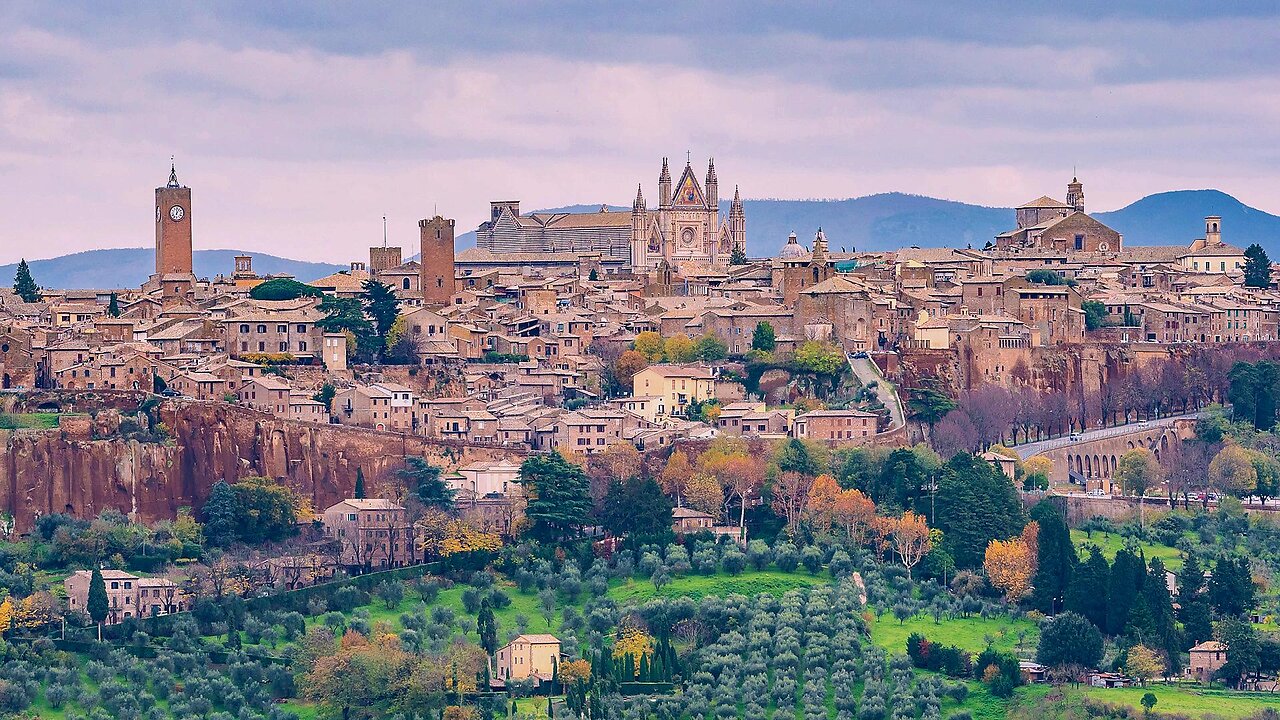Premium Only Content

Orvieto (AUD ENG)
Orvieto is a city and comune in the Province of Terni, southwestern Umbria, Italy, situated on the flat summit of a large butte of volcanic tuff. The city rises dramatically above the almost-vertical faces of tuff cliffs that are completed by defensive walls built of the same stone.
The ancient city (urbs vetus in Latin, whence "Orvieto"), populated since Etruscan times, has usually been associated with Etruscan Velzna, but some modern scholars differ. Orvieto was certainly a major centre of Etruscan civilization; the archaeological museum (Museo Claudio Faina e Museo Civico) houses some of the Etruscan artifacts that have been recovered in the immediate area. A tomb in the Orvieto Cannicella necropolis bears the inscription mi aviles katacinas, "I am of Avile Katacina"; the tomb's occupant thus bore an Etruscan-Latin first name, Aulus, and a family name that is believed to be of Celtic origin (derived from "Catacos").
Orvieto was annexed by Rome in the third century BC. Because of its site on a high, steep bluff of tuff, a volcanic rock, the city was virtually impregnable. After the collapse of the Roman Empire its defensible site gained new importance: the episcopal seat was transferred from Bolsena, and the city was held by Goths and by Lombards before its self-governing commune was established in the tenth century, in which consuls governed under a feudal oath of fealty to the bishop. Orvieto, sitting on its impregnable rock controlling the road between Florence and Rome where it crossed the Chiana, was a large town: its population numbered about 30,000 at the end of the 13th century.
The city of Orvieto has long kept the secret of its labyrinth of caves and tunnels that lie beneath the surface. Dug deep into the tuff, a volcanic rock, these secret hidden tunnels are now open to view only through guided tours. The underground city boasts more than 1200 tunnels, galleries, wells, stairs, quarries, cellars, unexpected passageways, cisterns, superimposed rooms with numerous small square niches for pigeon roosts, detailing its creation over the centuries. Many of the homes of noble families were equipped with a means of escape from the elevated city during times of siege through secret escape tunnels carved from the soft rock. The tunnels would lead from the city palazzo to emerge at a safe exit point some distance away from city walls.
The city became one of the major cultural centers of its time when Thomas Aquinas taught at the studium there. A small university (now part of the University of Perugia), had its origins in a studium generale that was granted to the city by Pope Gregory IX in 1236. The territory of Orvieto was under papal control long before it was officially added to the Papal States. It remained a papal possession until 1860, when it was annexed to a unified Italy.
-
 59:27
59:27
Adaneth - History&Politics
21 hours agoSuez: A very British Crisis | Conspiracy (Episode 2)
25 -
 LIVE
LIVE
VINCE
2 hours agoGov't Shutdown Is Blowing Up In Dems' Faces | Episode 157 - 10/29/25
36,364 watching -

Graham Allen
2 hours agoDems Are The Party Of VIOLENCE!! + Gov Reopening Blocked AGAIN And Newsom IS Suing Trump!!
75.4K29 -
 LIVE
LIVE
Benny Johnson
1 hour ago👑 Trump Crowned ‘MAGA King’ in Korea | Live Right Now With New Jersey’s Next REPUBLICAN Governor...
3,785 watching -
 LIVE
LIVE
Badlands Media
4 hours agoBadlands Daily: October 29, 2025
3,034 watching -
 LIVE
LIVE
Matt Kohrs
10 hours agoStock Market Open: Fed Rate Decision Day! || Live Trading FOMC
570 watching -
 LIVE
LIVE
Wendy Bell Radio
6 hours agoBurning Down The House
7,442 watching -
 LIVE
LIVE
Total Horse Channel
13 hours ago2025 IRCHA Derby & Horse Show - October 29th
62 watching -
 1:07:54
1:07:54
Chad Prather
16 hours agoHow to Keep Your Peace When Your World Falls Apart!
53.6K29 -
 LIVE
LIVE
LFA TV
13 hours agoLIVE & BREAKING NEWS! | WEDNESDAY 10/29/25
3,159 watching